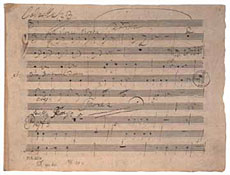Trivia
Violin masterpieces: Concertos I
In addition to the solos introduced in the previous section, there are many violin masterpieces played with the backing of an orchestra. In this section we introduce a selection of these pieces.
Vivaldi: Violin Concerti 1-4, Op. 8 "The Four Seasons"
This is one of the most well-known classical pieces of all time. The piece is arranged from four concertos: No. 1 "Spring," No. 2 "Summer," No. 3 "Autumn," and No. 4 "Winter." The solo parts are characterized by very technical violin playing, and the concertos feature beautiful melodies making them worth listening to even as solo concertos. The overall musical theme is quite dramatic, and selections can be found in the scores to many movies and TV shows.
Mozart: Violin Concerto No. 5 in A Major, K.219 "Turkish"
Mozart was a true genius who left behind many violin pieces. He composed five concertos (some would argue seven), and an astonishing 43 violin sonatas. The reason why Mozart wrote so much violin music is simple: he himself was an expert violinist. The fact that he was appointed as concertmaster of the court orchestra in Salzburg at age 13 says all that needs to be said about his skill at the piano, violin, and viola. This piece gets its name due to the sudden key and tempo change during the middle of the third movement ("Rondo"), in which the music takes on a foreign key (called the "Turkish style" back then).
Beethoven: Violin Concerto in D Major, Op. 61
This is Beethoven's sole violin concerto. Sometimes referred to as the "king" of violin concertos, it has a suitably majestic theme and is full of wonderful melodies. However, there are hardly any sections that a violinist can really show off in, so it is said to be a very difficult piece to perform. Put another way, it requires pure expressive ability, beautiful playing, and even deep spirituality, so any violinist should attempt the piece at least once.

Beethoven's handwritten violin concerto
Musical Instrument Guide : Violin Contents
Origins
Structure
How to Play
How the Instrument is Made
Choosing an Instrument
Care and Maintenance
Trivia
- The f-hole used to be a C-hole or S-hole
- Why the f-hole?
- Violinists must bow to the horse
- Steel strings or gut strings? That is the question
- Is the chinrest the unsung hero of the violin?
- Most violin varnishes are also medicines
- Violin masterpieces: Solos I
- Violin masterpieces: Solos II
- Violin masterpieces: Solos III
- Violin masterpieces: Concertos I
- Violin masterpieces: Concertos II
- Viola masterpieces: Chamber music
- Viola masterpieces: Concertos
- Cello masterpieces: Concertos I
- Cello masterpieces: Concertos II
- Cello masterpieces: Solos
- Contrabass masterpieces: Concertos
- Contrabass masterpieces: Chamber music
- Orchestral masterpieces featuring the contrabass
- What do you call the part on the bow that you hold?
